Vegetation in Archaeological Areas: Risks, Opportunities, and Guidelines to Preserve or Remove: An Italian Case Study
Abstract
1. Introduction
2. Case Study
3. Methodology
- (a).
- Interpretation of outdoor data: Physiological Equivalent Temperature—PET [56], air temperature (Ta, in °C), relative humidity (RH, in %), and mean radiant temperature (Tmrt, °C).
- (b).
- Evaluation of the plant species that can be eliminated and cannot be eliminated for comfort/microclimate.
- (c).
- A scenario in which some plant species, with high VHI index (IP > 7), are eliminated.
- (d).
- A scenario in which sedum (a genus of succulent plants belonging to the Crassulaceae family) is added to damaged portions of the bleachers.
3.1. Outdoor Microclimate Modelling and Simulation
3.2. Identification of Plant Species to Be Eliminated with High VHI Index
- The biological form of a plant: The final size of the plant after growth and habit (herbaceous, shrubby, liana, arboreal plants). The species included in the model starting from Envimet’s “Tree” database, which includes the data canopy tree, leaf type and leaf area, foliage shortwave albedo, foliage shortwave transmittance, and emissivity of leaves.
- The invasiveness and vigour, referring to the mode of growth (plants with limited or invasive growth) and tendency to spread by vegetative propagation (the ability of many plants to regenerate missing parts or entire individuals starting from portions).
- The root system, which can be more or less extensive, deep and/or intrusive. The species were included in the model from Envimet’s “Tree” database, which includes Root Zone, Root diameter, and Root depth data.
- The VHI index values from VHI = 0 to VHI = 3 indicate plants that can be considered not particularly hazardous to buildings and are therefore generally negligible in vegetation control operations.
- From VHI = 4 to VHI = 6, the plants are moderately dangerous, and the necessity of intervention must be evaluated on a case-by-case basis. Factors such as abundance and any aesthetic and/or cultural value may be taken into account in this evaluation.
- From VHI = 7 to VHI = 10, the plants are highly dangerous, and intervention is generally necessary.
3.3. Microclimatic Modelling of Intervention Scenarios
3.4. Evaluation
4. Results
5. Discussion
The Limits of the Research
6. Conclusions
- The relationship between the presence of visitors and the microclimatic conditions of the archaeological site.
- The role of vegetation in defining microclimatic conditions in archaeological sites.
- Evaluations on how to balance the beneficial effect of trees with a high VHI index with other vegetation that guarantees the same OTC but is more suitable for archaeological sites (e.g., adopt 3 m2 of sedum instead of pine).
- The relationship between conservation needs and the variables given by the microclimatic context.
- Define a specific risk index for visitors to archaeological sites, based not only on climate data.
Author Contributions
Funding
Institutional Review Board Statement
Informed Consent Statement
Data Availability Statement
Conflicts of Interest
References
- IPCC Annex I: Glossary. In Global Warming of 1.5 °C; Cambridge University Press: Cambridge, UK, 2022; pp. 541–562.
- Pasikowska-Schnass, M. The Impact of Climate Change on Cultural Heritage; European Parliamentary Research Service: Brussels, Luxembourg, 2024. [Google Scholar]
- Falk, M.T.; Hagsten, E. Probability and severity of climate change threats to natural world heritage sites vary across site specifics and over time. Sci. Total Environ. 2024, 946, 174291. [Google Scholar] [CrossRef] [PubMed]
- UNESCO. Policy Document on Climate Action for World Heritage; Cambridge University Press: Cambridge, UK, 2023. [Google Scholar]
- UNESCO. Managing Disaster Risks for World Heritage; UNESCO: Paris, France, 2010; ISBN 9789231041655. [Google Scholar]
- Marino, L. Il Rischio Nelle Aree Archeologiche; Alinea: Florence, Italy, 2013. [Google Scholar]
- Ferdyn-Grygierek, J. Indoor Environment Quality in the Museum Building and Its Effect on Heating and Cooling Demand. Energy Build. 2014, 85, 32–44. [Google Scholar] [CrossRef]
- Pavlogeorgatos, G. Environmental Parameters in Museums. Build. Environ. 2003, 38, 1457–1462. [Google Scholar] [CrossRef]
- Ferdyn-Grygierek, J. Monitoring of indoor air parameters in large museum exhibition halls with and without air-conditioning system. Build. Environ. 2016, 107, 113–126. [Google Scholar] [CrossRef]
- Ceschin, S.; Salerno, G.; Caneva, G. Multitemporal Floristic Analysis on a Humid Area in Rome’s Archaeological Site as Indicator for Environmental Change. Environ. Monit. Assess. 2009, 149, 29–42. [Google Scholar] [CrossRef]
- Manacorda, D. Il Sito Archeologico: Fra Ricerca e Valorizzazione; Carocci: Rome, Italy, 2007. [Google Scholar]
- Fabbri, K.; Canuti, G.; Ugolini, A. A Methodology to Evaluate Outdoor Microclimate of the Archaeological Site and Vegetation Role: A Case Study of the Roman Villa in Russi (Italy). Sustain. Cities Soc. 2017, 35, 107–133. [Google Scholar] [CrossRef]
- Fabbri, K.; Ugolini, A.; Iacovella, A.; Bianchi, A.P. The Effect of Vegetation in Outdoor Thermal Comfort in Archaeological Area in Urban Context. Build. Environ. 2020, 175, 106816. [Google Scholar] [CrossRef]
- Bettini, C.; Cinquanta, A. La Vegetazione e i Monumenti. Esigenze e Metodologie Nel Controllo Delle Infestanti Ruderali; Union Printing: Viterbo, Italy, 1990. [Google Scholar]
- Caneva, G.; Galotta, G.; Cancellieri, L.; Savo, V. Tree Roots and Damages in the Jewish Catacombs of Villa Torlonia (Roma). J. Cult. Herit. 2009, 10, 53–62. [Google Scholar] [CrossRef]
- Dahmani, J.; Benharbit, M.; Fassar, M.; Hajila, R.; Zidane, L.; Magri, N.; Belahbib, N. Vascular Plants Census Linked to the Biodeterioration Process of the Portuguese City of Mazagan in El Jadida, Morocco. J. King Saud. Univ. Sci. 2020, 32, 682–689. [Google Scholar] [CrossRef]
- Caneva, G.; Nungari, M.P.; Salvadori, O. La Biologia Vegetale per i Beni Culturali, Biodeterioramento e Conservazione; Nardini Editore: Florence, Italy, 2007. [Google Scholar]
- Li, Y.; Xia, C.; Wu, R.; Ma, Y.; Mu, B.; Wang, T.; Petropoulos, E.; Hokoi, S. Role of the Urban Plant Environment in the Sustainable Protection of an Ancient City Wall. Build. Environ. 2021, 187, 107405. [Google Scholar] [CrossRef]
- Malys, L.; Musy, M.; Inard, C. A Hydrothermal Model to Assess the Impact of Green Walls on Urban Microclimate and Building Energy Consumption. Build. Environ. 2014, 73, 187–197. [Google Scholar] [CrossRef]
- Chang, B.; Liu, X.; Luo, X.; Feng, Z.; Gu, Z. Mold Growth under Near-Saturated Preservation Environment of Unearthed Relics within Archaeological Museums. Sustain. Cities Soc. 2023, 93, 104517. [Google Scholar] [CrossRef]
- Minissale, P.; Trigilia, A.; Brogna, F.; Sciandrello, S. Plants and Vegetation in the Archaeological Park of Neapolis of Syracuse (Sicily, Italy): A Management Effort and Also an Opportunity for Better Enjoyment of the Site. Conserv. Manag. Archaeol. Sites 2015, 17, 340–369. [Google Scholar] [CrossRef]
- Isola, D.; Bartoli, F.; Morretta, S.; Caneva, G. The Roman Houses of the Caelian Hill (Rome, Italy): Multitemporal Evaluation of Biodeterioration Patterns. Microorganisms 2023, 11, 1770. [Google Scholar] [CrossRef] [PubMed]
- Caneva, G.; Langone, S.; Bartoli, F.; Cecchini, A.; Meneghini, C. Vegetation Cover and Tumuli’s Shape as Affecting Factors of Microclimate and Biodeterioration Risk for the Conservation of Etruscan Tombs (Tarquinia, Italy). Sustainability 2021, 13, 3393. [Google Scholar] [CrossRef]
- Caneva, G.; Hosseini, Z.; Bartoli, F. Risk, Hazard, and Vulnerability for Stone Biodeterioration Due to Higher Plants: The Methodological Proposal of a Multifactorial Index (RHV). J. Cult. Herit. 2023, 62, 217–229. [Google Scholar] [CrossRef]
- Cicinelli, E.; Zangari, G.; Bartoli, F.; Isola, D.; Lucchese, F.; Caneva, G. Protecting Monuments and Plant Biodiversity in Archaeological Sites: The Case of the Etruscan Necropolis of “Monterozzi” (Tarquinia, Central Italy). Acta Hortic. 2022, 1345, 123–128. [Google Scholar] [CrossRef]
- Mascaro, M.E.; Pellegrino, G.; Palermo, A.M. Analysis of Biodeteriogens on Architectural Heritage. An Approach of Applied Botany on a Gothic Building in Southern Italy. Sustainability 2021, 14, 34. [Google Scholar] [CrossRef]
- Caneva, G. A Botanical Approach to the Planning of Archaeological, Parks in Italy. Conserv. Manag. Archaeol. Sites 1999, 3, 127–134. [Google Scholar] [CrossRef]
- Ugolini, A.; Matteini, T. Design and Active Conservation on Archaeological Landscapes. New Windows of Research for an Interdisciplinary Reading. In Proceedings of the Conservazione e Valorizzazione Dei Siti Archeologici: Approcci Scientifici e Problemi di Metodo; Driussi, G., Bisconti, G., Eds.; Arcadia: Brixen, Italy, 2013; pp. 527–538. [Google Scholar]
- Boni, G.; La Flora Delle Ruine. Nuova Antologia Di Lettere, Scienze Ed Arti 1917. Available online: https://archive.org/details/sim_nuova-antologia-revista-di-lettere-scienze-ed-arti_1917_274_index (accessed on 16 March 2025).
- Boni, G. Flora Palatina Vegetazione Ed Archeologia; Carcia Barraco, M.E., Ed.; Tipografia Roma: Rome, Italy, 1912. [Google Scholar]
- Signorini, M.A. L’indice Di Pericolosità: Un Contributo Del Botanico al Controllo Della Vegetazione Infestante Nelle Aree Monumentali. Inf. Bot. Ital. 1996, 28, 7–14. [Google Scholar]
- Bottini, M. (Ed.) La Pieve di San Giovanni in Galilea; Litografia il Papiro: Cesena, Italy, 2010. [Google Scholar]
- Jansen, M. Archaeological Preservation and Documentation; UNESCO: Paris, France, 1993. [Google Scholar]
- Lowerre, A. Hailes Abbey, Stanway, Gloucestershire Hailes Abbey Culvert Evaluation Assessment Report; English Heritage: Swidon, UK, 2012. [Google Scholar]
- De Marco, G.; Caneva, G.; Dinelli, A. Protezione Vegetale Su Strutture Di Tufo. Esperienze Sulle Pendici Del Palatino. Mater. Strutt. 2005, 5–6, 165–175. [Google Scholar]
- Höppe, P. Aspects of Human Biometerology in Past, Present and Future. Int. J. Biometeorol. 1997, 40, 19–23. [Google Scholar] [CrossRef]
- Höppe, P. The Physiological Equivalent Temperature—A Universal Index for the Biometeorological Assessment of the Thermal Environment. Int. J. Biometeorol. 1999, 43, 71–75. [Google Scholar] [CrossRef] [PubMed]
- Mayer, H.; Hoppe, P. Thermal Comfort of Man in Different Urban Environments. Theor. Appl. Climatol. 1987, 38, 43–49. [Google Scholar] [CrossRef]
- Gosling, S.N.; Bryce, E.K.; Dixon, P.G.; Gabriel, K.M.A.; Gosling, E.Y.; Hanes, J.M.; Hondula, D.M.; Liang, L.; Bustos Mac Lean, P.A.; Muthers, S.; et al. A Glossary for Biometeorology. Int. J. Biometeorol. 2014, 58, 277–308. [Google Scholar] [CrossRef] [PubMed]
- Envi-Met. Available online: www.envi-met.com (accessed on 16 March 2025).
- Tsoka, S.; Tsikaloudaki, A.; Theodosiou, T. Analyzing the ENVI-Met Microclimate Model’s Performance and Assessing Cool Materials and Urban Vegetation Applications–A Review. Sustain. Cities Soc. 2018, 43, 55–76. [Google Scholar] [CrossRef]
- Yang, X.; Zhao, L.; Bruse, M.; Meng, Q. Evaluation of a Microclimate Model for Predicting the Thermal Behavior of Different Ground Surfaces. Build. Environ. 2013, 60, 93–104. [Google Scholar] [CrossRef]
- Jiang, L.; Lucchi, E.; Curto, D. Del Adaptive Reuse and Energy Transition of Built Heritage and Historic Gardens: The Sustainable Conservation of Casa Jelinek in Trieste (Italy). Sustain. Cities Soc. 2023, 97, 104767. [Google Scholar] [CrossRef]
- Xiong, Y.; Zhang, J.; Yan, Y.; Sun, S.; Xu, X.; Higueras, E. Effect of the Spatial Form of Jiangnan Traditional Villages on Microclimate and Human Comfort. Sustain. Cities Soc. 2022, 87, 104136. [Google Scholar] [CrossRef]
- Binarti, F.; Koerniawan, M.D.; Triyadi, S.; Matzarakis, A. The Predicted Effectiveness of Thermal Condition Mitigation Strategies for a Climate-Resilient Archaeological Park. Sustain. Cities Soc. 2022, 76, 103457. [Google Scholar] [CrossRef]
- Mahmoud, A.H.A. Analysis of the Microclimatic and Human Comfort Conditions in an Urban Park in Hot and Arid Regions. Build. Environ. 2011, 46, 2641–2656. [Google Scholar] [CrossRef]
- Yahia, M.W.; Johansson, E. Landscape Interventions in Improving Thermal Comfort in the Hot Dry City of Damascus, Syria—The Example of Residential Spaces with Detached Buildings. Landsc. Urban Plan. 2014, 125, 1–16. [Google Scholar] [CrossRef]
- Xiong, Y.; Zhang, J.; Xu, X.; Yan, Y.; Sun, S.; Liu, S. Strategies for Improving the Microclimate and Thermal Comfort of a Classical Chinese Garden in the Hot-Summer and Cold-Winter Zone. Energy Build. 2020, 215, 109914. [Google Scholar] [CrossRef]
- Luo, X.; Lei, S.; Tian, W.; Gu, Z. Evaluation of Air Curtain System Orientated to Local Environmental Control of Archaeological Museum: A Case Study for the Stone Armor Pit of Emperor Qin’s Mausoleum Museum. Sustain. Cities Soc. 2020, 57, 102121. [Google Scholar] [CrossRef]
- Luo, X.; Gu, Z.; Yu, C.W.; Li, K.; Xiao, B. Preservation of in Situ Artefacts by Local Heating in Earthen Pit in Archaeology Museum in Cold Winter. Build. Environ. 2016, 99, 29–43. [Google Scholar] [CrossRef]
- Li, Y.; Hu, X.; Xie, H.; Wu, R.; Zhang, Z.; Guo, Q.; Hokoi, S. The Impact of Cave Opening and Closure on Murals Hygrothermal Behavior in Cave 98 of Mogao Caves, China. Build. Environ. 2024, 256, 111502. [Google Scholar] [CrossRef]
- Belda, M.; Holtanová, E.; Halenka, T.; Kalvová, J. Climate Classification Revisited: From Köppen to Trewartha. Clim. Res. 2014, 59, 1–13. [Google Scholar] [CrossRef]
- Kottek, M.; Grieser, J.; Beck, C.; Rudolf, B.; Rubel, F. World Map of the Köppen-Geiger Climate Classification Updated. Meteorol. Z. 2006, 15, 259–263. [Google Scholar] [CrossRef]
- Weatherspark Falerone. Available online: https://weatherspark.com/y/74947/Average-Weather-in-Falerone-Italy-Year-Round (accessed on 16 May 2024).
- Andreou, E. Thermal Comfort in Outdoor Spaces and Urban Canyon Microclimate. Renew. Energy 2013, 55, 182–188. [Google Scholar] [CrossRef]
- Höppe, P. Different Aspects of Assessing Indoor and Outdoor Thermal Comfort. Energy Build. 2002, 34, 661–665. [Google Scholar] [CrossRef]
- Bröde, P.; Fiala, D.; Błażejczyk, K.; Holmér, I.; Jendritzky, G.; Kampmann, B.; Tinz, B.; Havenith, G. Deriving the Operational Procedure for the Universal Thermal Climate Index (UTCI). Int. J. Biometeorol. 2012, 56, 481–494. [Google Scholar] [CrossRef] [PubMed]
- Epstein, Y.; Moran, D.S. Thermal Comfort and the Heat Stress Indices. Ind. Health 2006, 44, 388–398. [Google Scholar] [CrossRef] [PubMed]
- Jendritzky, G.; de Dear, R.; Havenith, G. UTCI—Why Another Thermal Index? Int. J. Biometeorol. 2012, 56, 421–428. [Google Scholar] [CrossRef] [PubMed]
- Cassidy, A.; Paddison, L. Greece Shuts Acropolis to Protect Tourists from Blistering Heat. Available online: https://edition.cnn.com/2024/06/12/climate/greece-shuts-acropolis-heat-climate-intl/index.html (accessed on 12 June 2024).
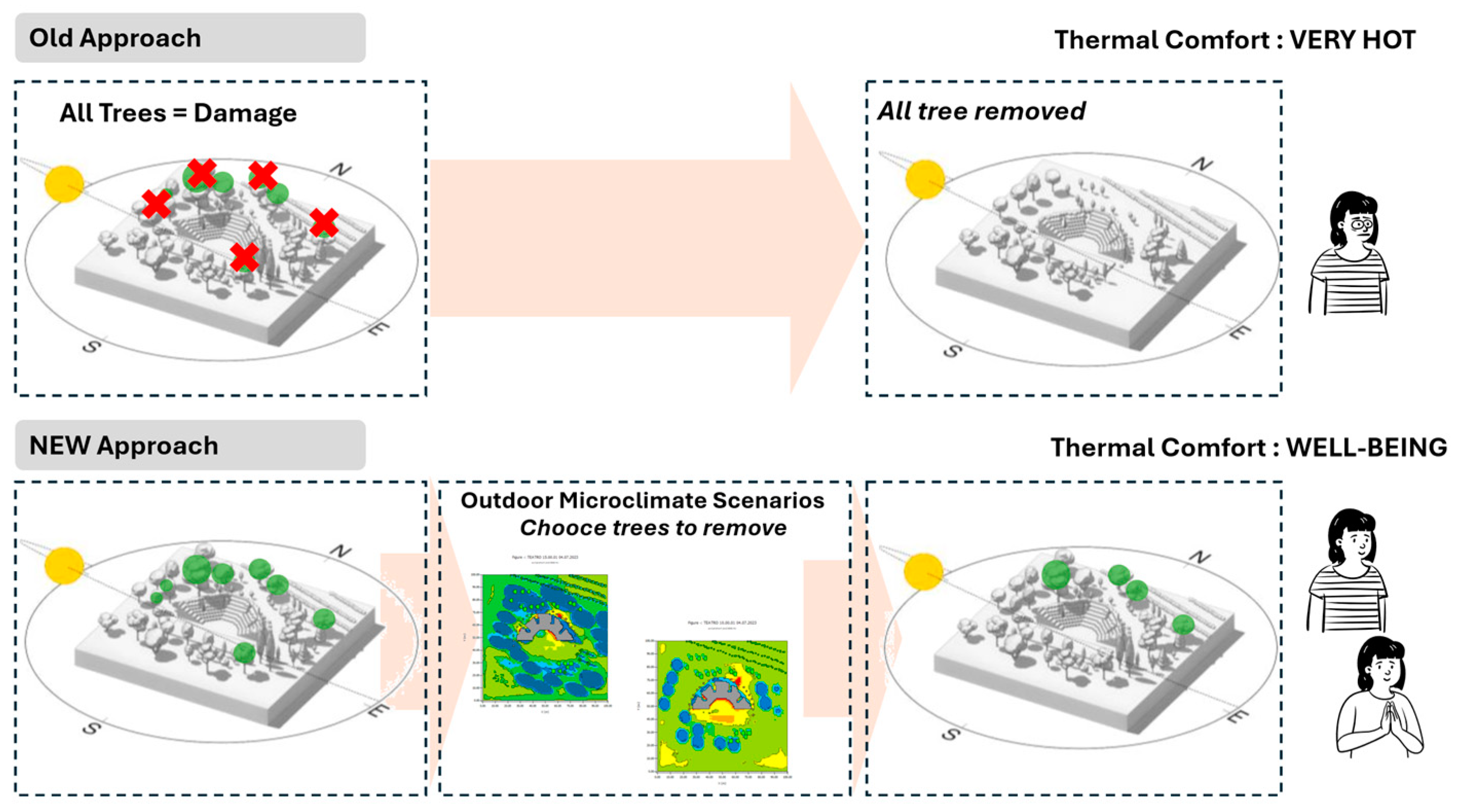
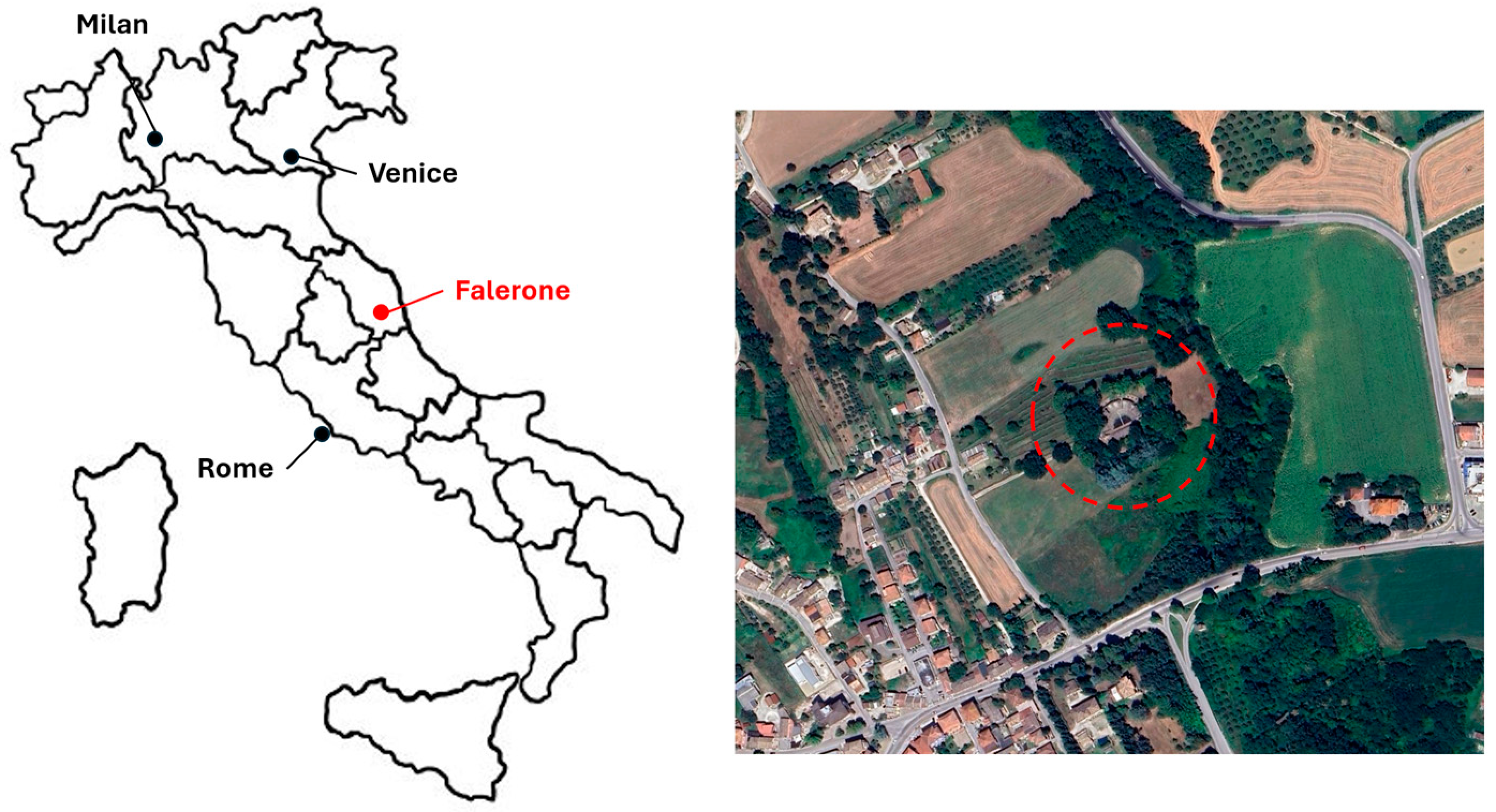
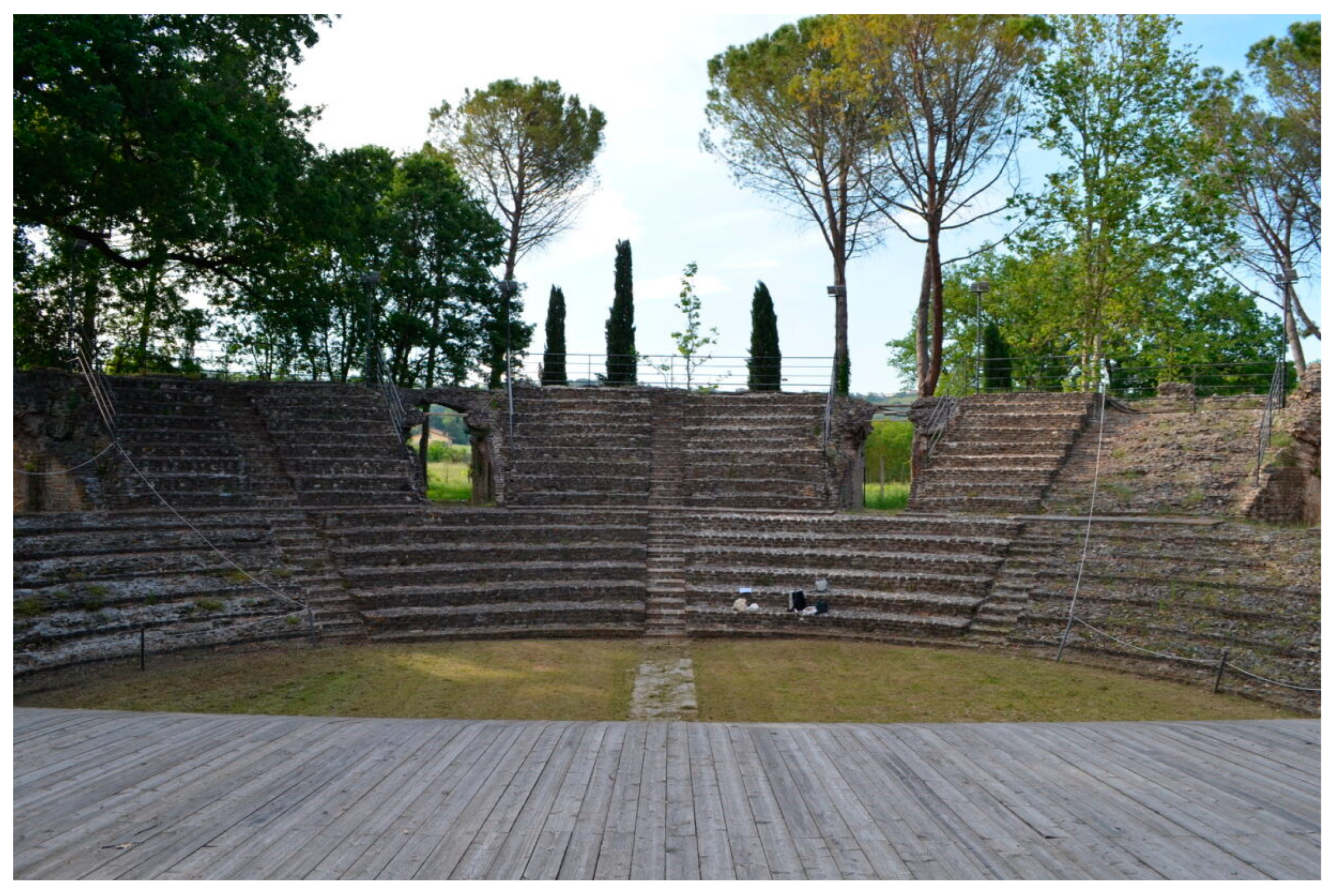
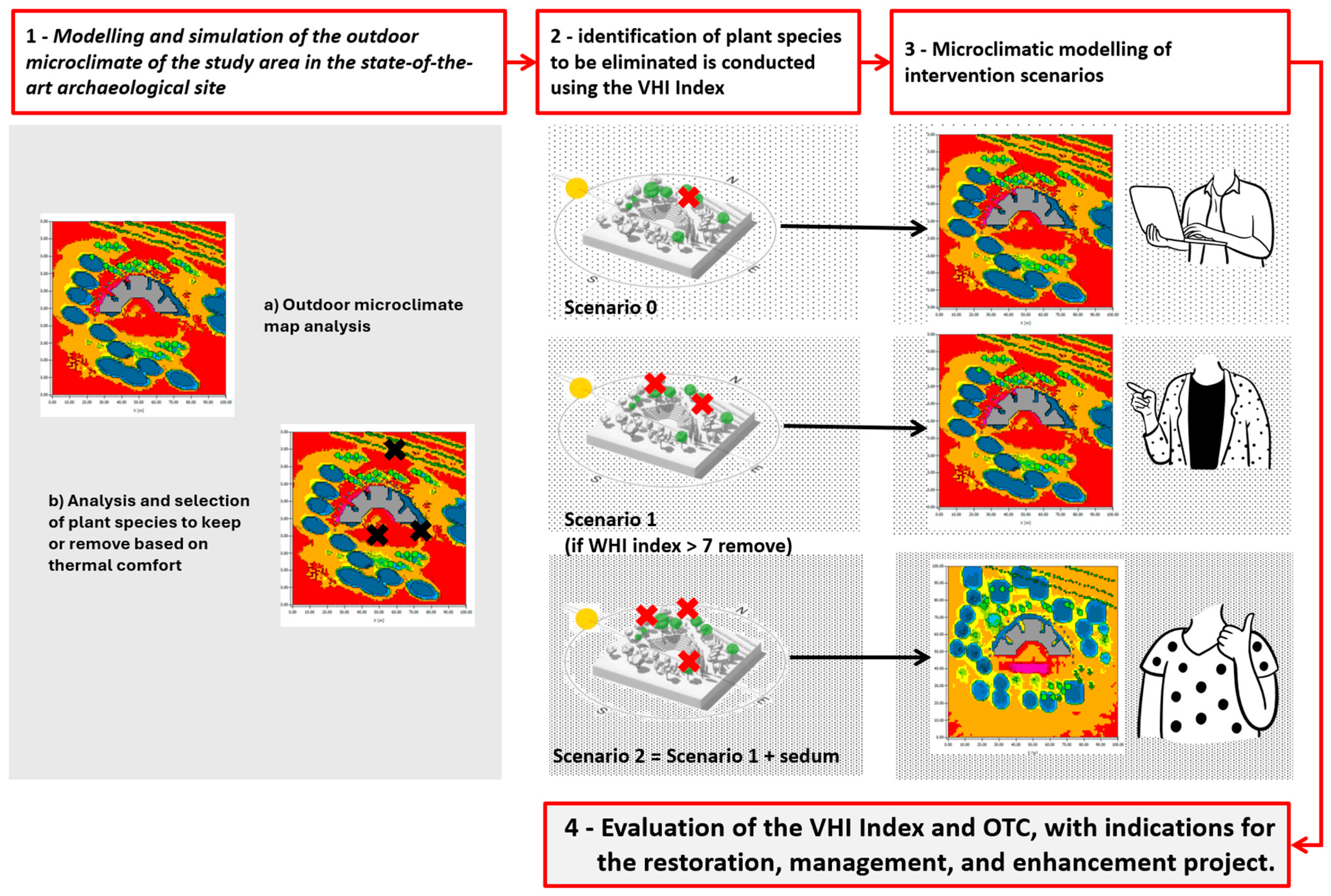
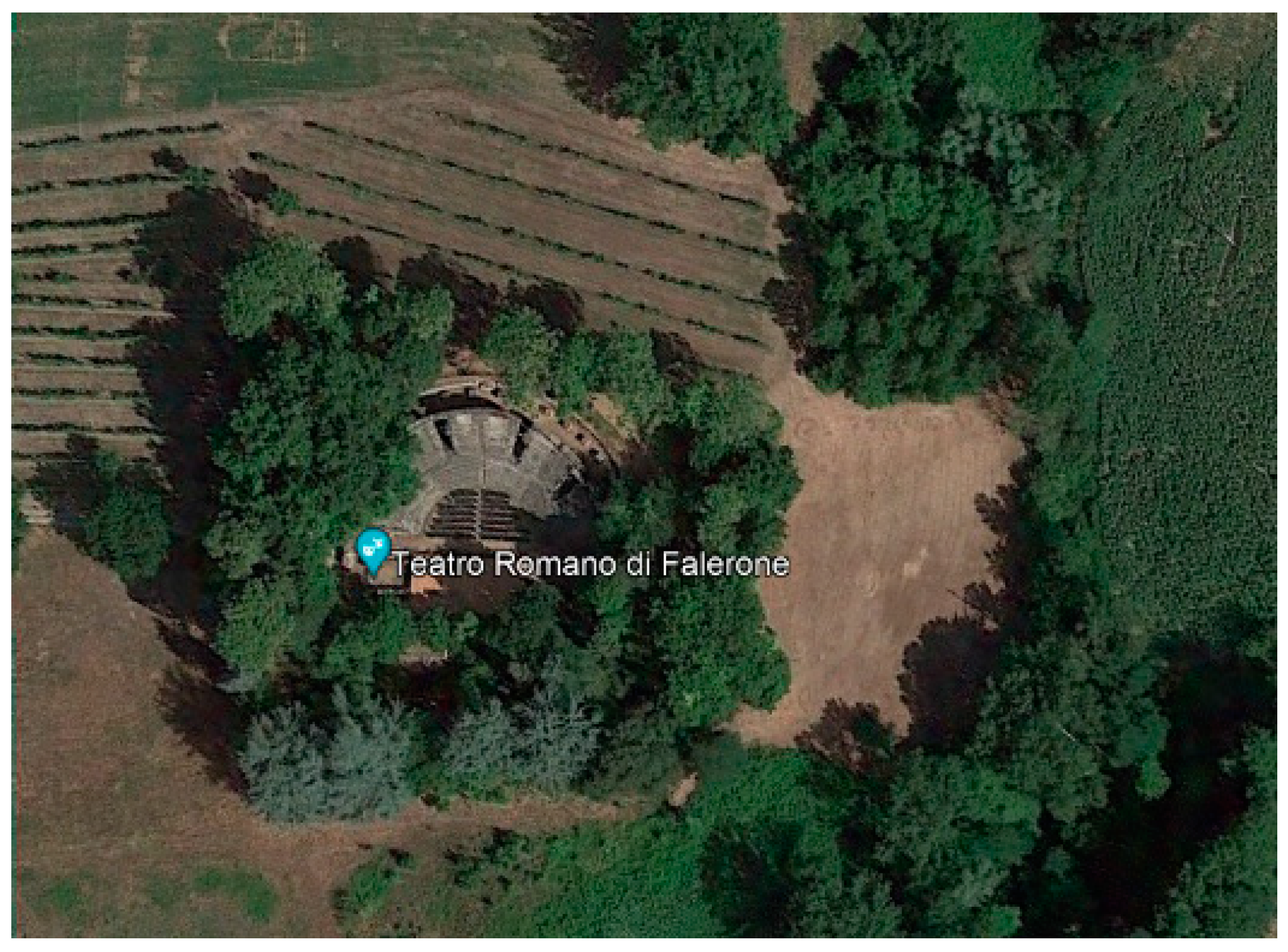
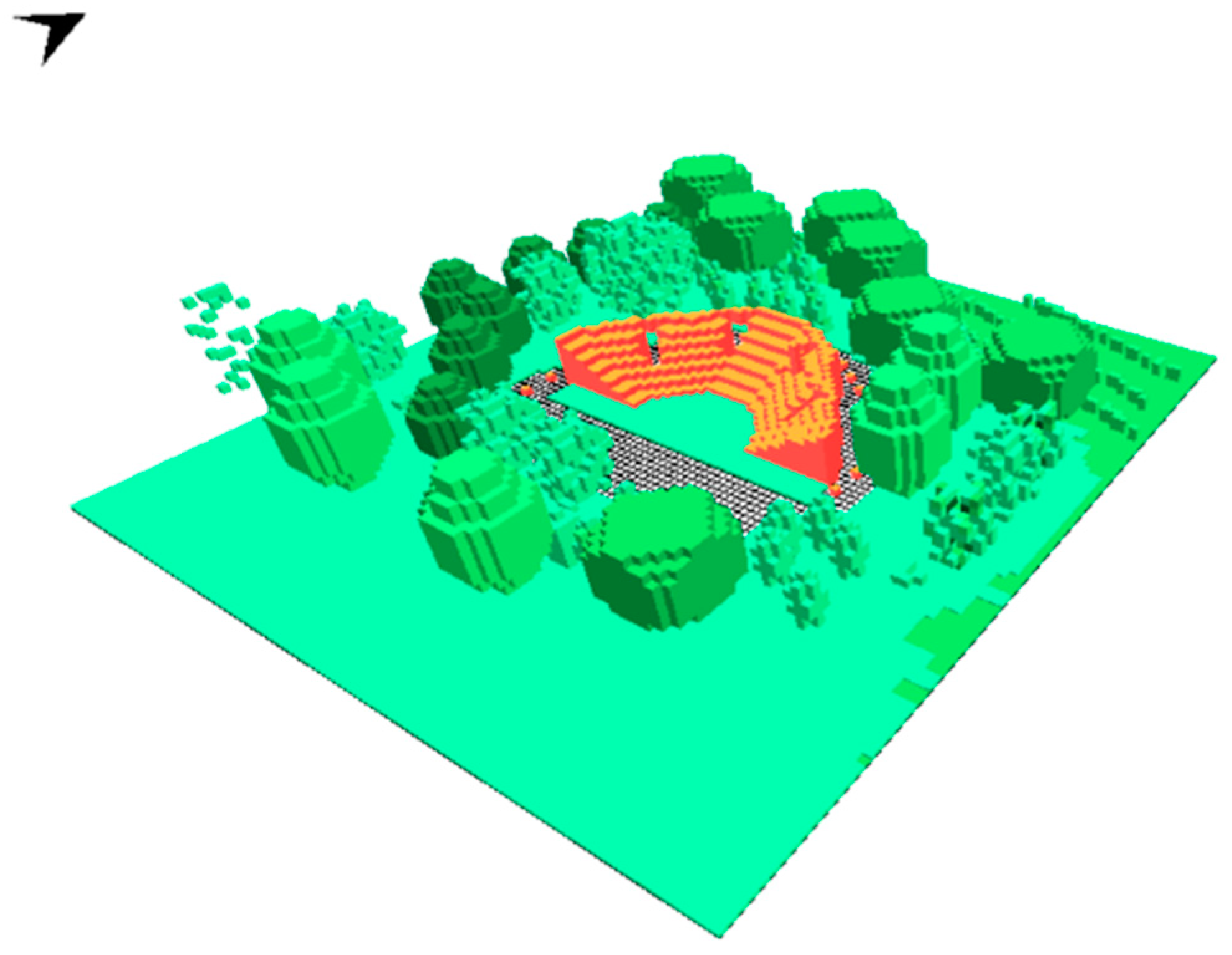

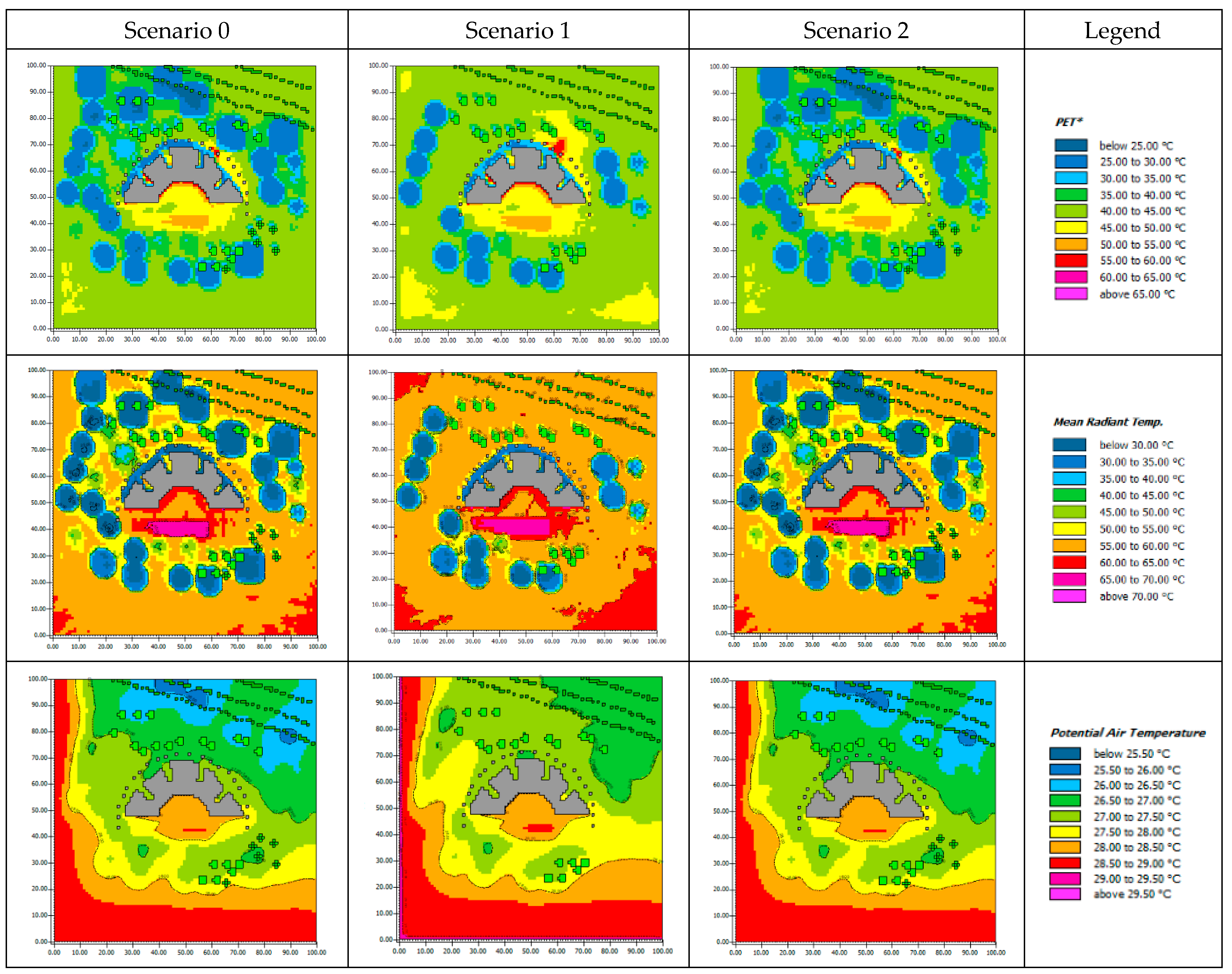
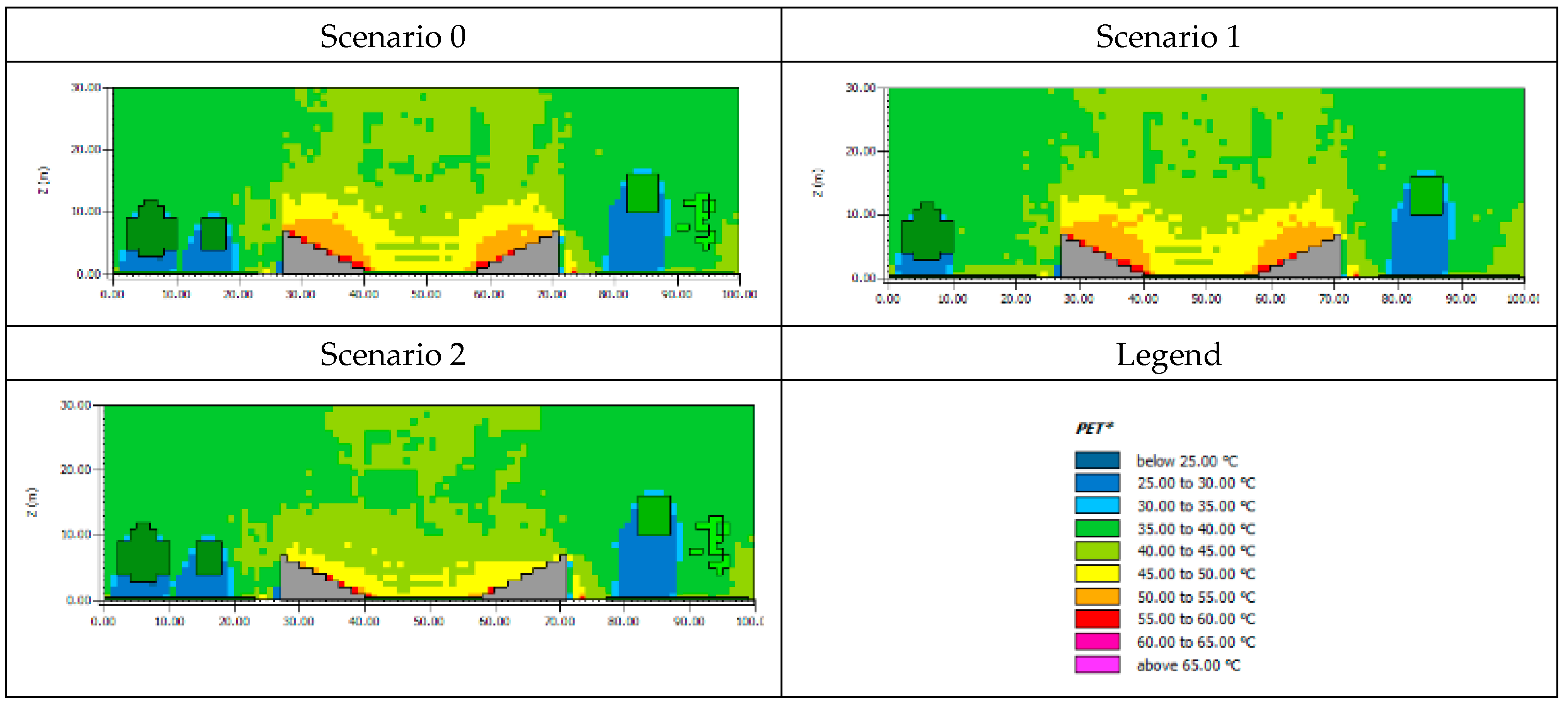
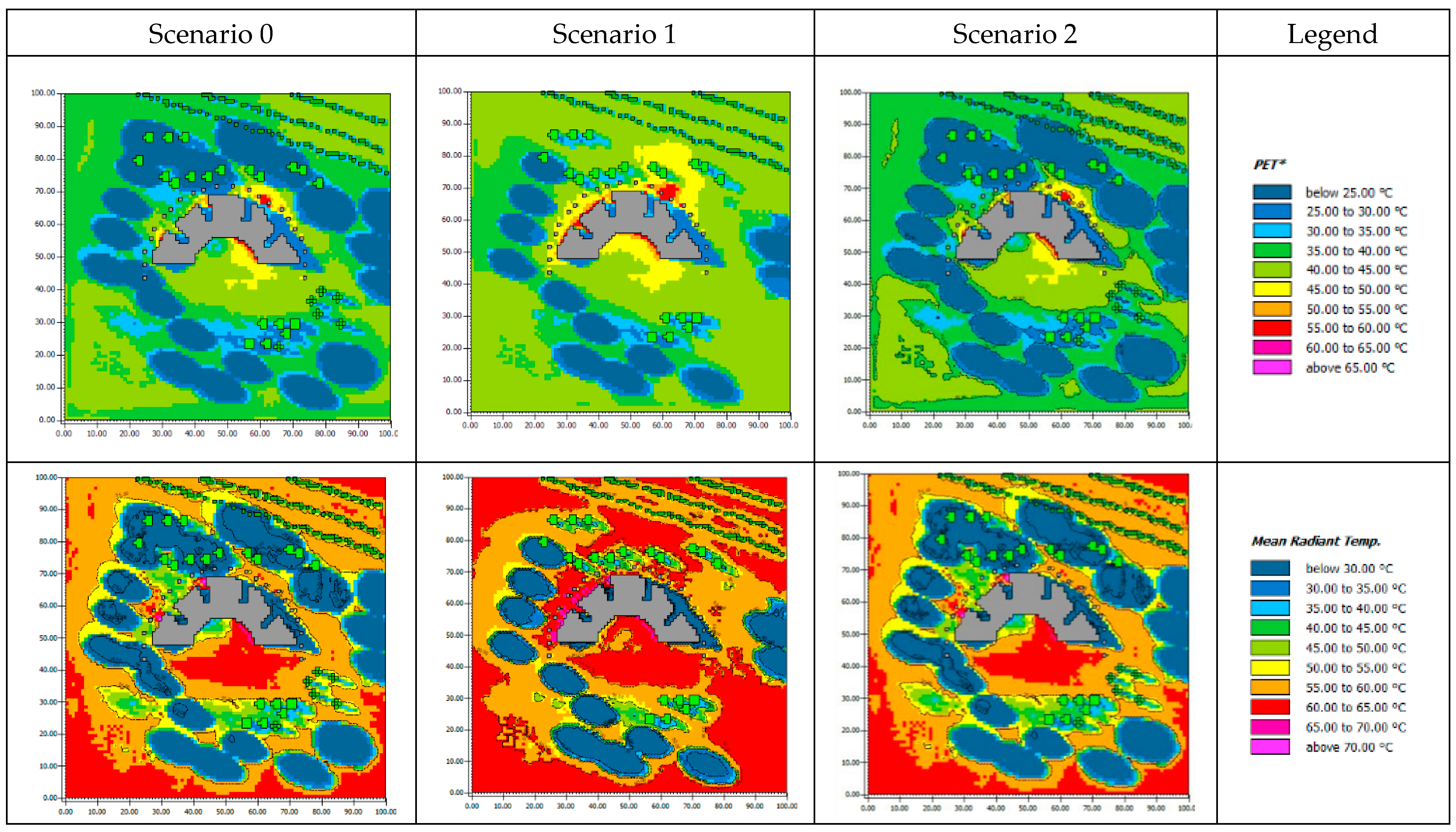

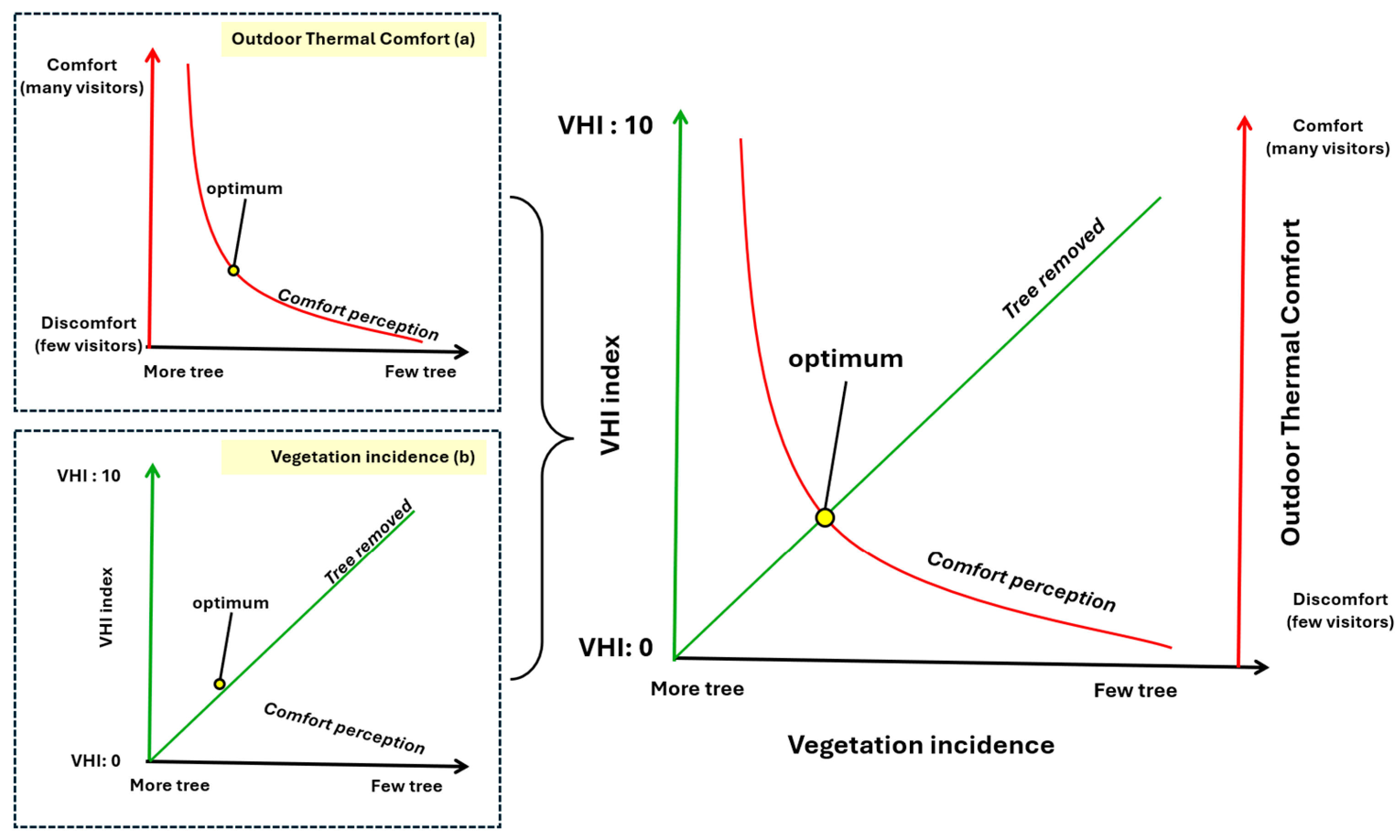
| Biological Shape | Invasive and Strength | Root | Dangerousness Index |
|---|---|---|---|
| 0—Annual tree | 0.0 Crawling and not crawling | 0.0.0 without taproot | 0 |
| 0.0.1 slightly taproot | 1 | ||
| 0.0.2 robust taproot | 2 | ||
| 0.1 Reptants | 0.1.0 without taproot | 1 | |
| 0.1.1 slightly taproot | 2 | ||
| 0.1.2 robust taproot | 3 | ||
| 0.2 A Vigorous growth | 0.2.0 without taproot | 2 | |
| 0.2.1 slightly taproot | 3 | ||
| 0.2.2 robust taproot | 4 | ||
| 1—Biennial tree | 1.0 Crawling and not crawling | 1.0.0 without taproot | 1 |
| 1.0.1 slightly taproot | 2 | ||
| 1.0.2 robust taproot | 3 | ||
| 2—Never-ending Weed | 2.0 Moss and lichen | 2.0.0 without taproot | 2 |
| 2.1 Not intrusive grass | 2.1.0 without taproot | 3 | |
| 2.1.1 slightly taproot | 4 | ||
| 2.1.2 robust taproot | 5 | ||
| 2.2 Intrusive grass or vigorous grass | 2.2.0 without taproot | 4 | |
| 2.2.1 slightly taproot | 5 | ||
| 2.2.2 robust taproot | 6 | ||
| 3–4—Shrub | 3.0 Suffruticose | 3.0.0 not intrusive | 3 |
| 3.0.1 intrusive | 4 | ||
| 3.0.2 very intrusive | 5 | ||
| 4.0 Small shrub or not suckering shrub | 4.0.0 not intrusive | 4 | |
| 4.0.1 intrusive | 5 | ||
| 4.0.2 very intrusive | 6 | ||
| 4.1 Suckering shrub | 4.1.0 not intrusive | 5 | |
| 4.1.1 intrusive | 6 | ||
| 4.1.2 very intrusive | 7 | ||
| 4.2 Shrub with rooting suckers | 4.2.0 not intrusive | 6 | |
| 4.2.1 intrusive | 7 | ||
| 4.2.2 very intrusive | 8 | ||
| 5—Liana | 5.0 Not Sucker | 5.0.0 not intrusive | 5 |
| 5.0.1 intrusive | 6 | ||
| 5.0.2 very intrusive | 7 | ||
| 5.1 Sucker | 5.1.0 not intrusive | 6 | |
| 5.1.1 intrusive | 7 | ||
| 5.1.2 very intrusive | 8 | ||
| 6—Tree | 6.0 Small tree or not sucker | 6.0.0 not intrusive | 6 |
| 6.0.1 intrusive | 7 | ||
| 6.0.2 very intrusive | 8 | ||
| 6.1 With stump sprouts | 6.1.0 not intrusive | 7 | |
| 6.1.1 intrusive | 8 | ||
| 6.1.2 very intrusive | 9 | ||
| 6.2 Also radical sucker | 6.2.0 not intrusive | 8 | |
| 6.2.1 intrusive | 9 | ||
| 6.2.2 very intrusive | 10 |
Disclaimer/Publisher’s Note: The statements, opinions and data contained in all publications are solely those of the individual author(s) and contributor(s) and not of MDPI and/or the editor(s). MDPI and/or the editor(s) disclaim responsibility for any injury to people or property resulting from any ideas, methods, instructions or products referred to in the content. |
© 2025 by the authors. Licensee MDPI, Basel, Switzerland. This article is an open access article distributed under the terms and conditions of the Creative Commons Attribution (CC BY) license (https://creativecommons.org/licenses/by/4.0/).
Share and Cite
Fabbri, K.; Catalano, M.; Ugolini, A. Vegetation in Archaeological Areas: Risks, Opportunities, and Guidelines to Preserve or Remove: An Italian Case Study. Sustainability 2025, 17, 2712. https://doi.org/10.3390/su17062712
Fabbri K, Catalano M, Ugolini A. Vegetation in Archaeological Areas: Risks, Opportunities, and Guidelines to Preserve or Remove: An Italian Case Study. Sustainability. 2025; 17(6):2712. https://doi.org/10.3390/su17062712
Chicago/Turabian StyleFabbri, Kristian, Maria Catalano, and Andrea Ugolini. 2025. "Vegetation in Archaeological Areas: Risks, Opportunities, and Guidelines to Preserve or Remove: An Italian Case Study" Sustainability 17, no. 6: 2712. https://doi.org/10.3390/su17062712
APA StyleFabbri, K., Catalano, M., & Ugolini, A. (2025). Vegetation in Archaeological Areas: Risks, Opportunities, and Guidelines to Preserve or Remove: An Italian Case Study. Sustainability, 17(6), 2712. https://doi.org/10.3390/su17062712







